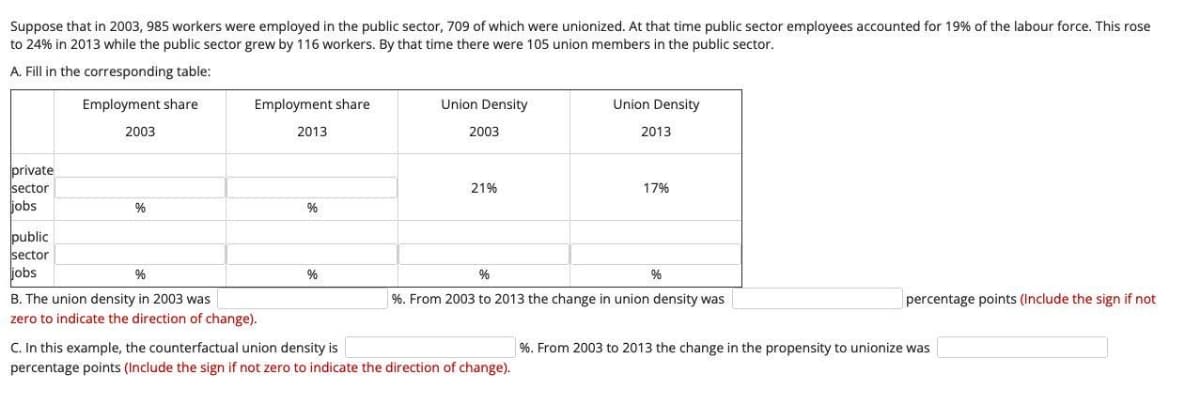Suppose that in 2003, 985 workers were employed in the public sector, 709 of which were unionized. At that time public sector employees accounted for 19% of the labour force. This rose to 24% in 2013 while the public sector grew by 116 workers. By that time there were 105 union members in the public sector. A. Fill in the corresponding table: Employment share Employment share Union Density Union Density 2003 2013 2003 2013 private sector jobs 21% 17% % public sector jobs % %. From 2003 to 2013 the change in union density was B. The union density in 2003 was zero to indicate the direction of change). percentage points (Include the sign if not C. In this example, the counterfactual union density is percentage points (Include the sign if not zero to indicate the direction of change). %. From 2003 to 2013 the change in the propensity to unionize was
Suppose that in 2003, 985 workers were employed in the public sector, 709 of which were unionized. At that time public sector employees accounted for 19% of the labour force. This rose to 24% in 2013 while the public sector grew by 116 workers. By that time there were 105 union members in the public sector. A. Fill in the corresponding table: Employment share Employment share Union Density Union Density 2003 2013 2003 2013 private sector jobs 21% 17% % public sector jobs % %. From 2003 to 2013 the change in union density was B. The union density in 2003 was zero to indicate the direction of change). percentage points (Include the sign if not C. In this example, the counterfactual union density is percentage points (Include the sign if not zero to indicate the direction of change). %. From 2003 to 2013 the change in the propensity to unionize was
Principles of Economics 2e
2nd Edition
ISBN:9781947172364
Author:Steven A. Greenlaw; David Shapiro
Publisher:Steven A. Greenlaw; David Shapiro
Chapter21: Unemployment
Section: Chapter Questions
Problem 11RQ: If you an? out of school but working part time, are you considered employed or unemployed in U.S....
Related questions
Question
7

Transcribed Image Text:Suppose that in 2003, 985 workers were employed in the public sector, 709 of which were unionized. At that time public sector employees accounted for 19% of the labour force. This rose
to 24% in 2013 while the public sector grew by 116 workers. By that time there were 105 union members in the public sector.
A. Fill in the corresponding table:
Employment share
Employment share
Union Density
Union Density
2003
2013
2003
2013
private
sector
jobs
21%
17%
%
public
sector
jobs
%
%
%
%
B. The union density in 2003 was
%. From 2003 to 2013 the change in union density was
percentage points (Include the sign if not
zero to indicate the direction of change).
C. In this example, the counterfactual union density is
%. From 2003 to 2013 the change in the propensity to unionize was
percentage points (Include the sign if not zero to indicate the direction of change).
Expert Solution
This question has been solved!
Explore an expertly crafted, step-by-step solution for a thorough understanding of key concepts.
Step by step
Solved in 2 steps with 3 images

Knowledge Booster
Learn more about
Need a deep-dive on the concept behind this application? Look no further. Learn more about this topic, economics and related others by exploring similar questions and additional content below.Recommended textbooks for you

Principles of Economics 2e
Economics
ISBN:
9781947172364
Author:
Steven A. Greenlaw; David Shapiro
Publisher:
OpenStax

Principles of Microeconomics
Economics
ISBN:
9781305156050
Author:
N. Gregory Mankiw
Publisher:
Cengage Learning

Microeconomics: Private and Public Choice (MindTa…
Economics
ISBN:
9781305506893
Author:
James D. Gwartney, Richard L. Stroup, Russell S. Sobel, David A. Macpherson
Publisher:
Cengage Learning

Principles of Economics 2e
Economics
ISBN:
9781947172364
Author:
Steven A. Greenlaw; David Shapiro
Publisher:
OpenStax

Principles of Microeconomics
Economics
ISBN:
9781305156050
Author:
N. Gregory Mankiw
Publisher:
Cengage Learning

Microeconomics: Private and Public Choice (MindTa…
Economics
ISBN:
9781305506893
Author:
James D. Gwartney, Richard L. Stroup, Russell S. Sobel, David A. Macpherson
Publisher:
Cengage Learning

Economics: Private and Public Choice (MindTap Cou…
Economics
ISBN:
9781305506725
Author:
James D. Gwartney, Richard L. Stroup, Russell S. Sobel, David A. Macpherson
Publisher:
Cengage Learning

Exploring Economics
Economics
ISBN:
9781544336329
Author:
Robert L. Sexton
Publisher:
SAGE Publications, Inc
